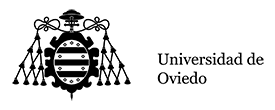Estudia
-
Artes y humanidades
- Grado en Estudios Clásicos y Románicos
- Grado en Estudios Ingleses
- Grado en Filosofía
- Grado en Geografía y Ordenación del Territorio
- Grado en Historia
- Grado en Historia del Arte
- Grado en Historia y Ciencias de la Música
- Grado en Lengua Española y sus Literaturas
- Grado en Lenguas Modernas y sus Literaturas
- Ciencias
- Ciencias de la salud
- Ciencias sociales y jurídicas
- Ingeniería y arquitectura
- Información, acceso y becas
Inglés para Fines Específicos de la Historia del Arte
- Prácticas de Laboratorio (42 Hours)
- Clases Expositivas (14 Hours)
English for Art History (IHA) is an optional subject within the transversal module that forms part of the Degree in History of Art at the University of Oviedo and is the only subject that develops the subject of the same name. It is taught during the 8th semester of the degree (second semester of the fourth year) and has a value of 6 ECTS credits (see Memoria de Verificación del Grado en Historia del Arte por la Universidad de Oviedo, section 5ª mainly). Its eminently instrumental nature aims to provide the linguistic resources necessary for students to understand texts related to Art History in English (given that a significant percentage of the reference bibliography for this speciality is written in that language) and to become familiar with the English terminology used in art-historical discourse, thus using it accurately. In this way, the subject responds to its instrumental and transversal nature, linking in with the rest of the subjects of the degree.
Apart from the general requirements for access to the Degree in History of Art at the University of Oviedo, the corresponding Verification Report establishes as a prerequisite for enrolment in the transversal module to which IHA belongs the possession of "general knowledge of History of Art" (5-34). On the other hand, it seems clear that in order to take advantage of this subject it is advisable that the student who enrols in it has, at least, a general knowledge of English equivalent to level A2, according to the scale of the Common European Framework of Reference for Languages, as it corresponds to all students who have completed their Baccalaureate studies and passed the university entrance exams. It is suggested, however, that the most appropriate level for students to benefit from the subject would be level B2, in accordance with the scale of the Common European Framework of Reference for Languages.
Competences
This course aims to provide students with the following main competences:
General:
- Understand a foreign language (English) and be able to express oneself in it.
- Take responsibility for their own learning process.
- Knowledge and ability to apply the scientific method
- Critical thinking skills
- Analytical and synthesis skills
- Acquire the ability to work in a team.
- Adapt to new situations in an international context.
- Appreciate and have Art History valued, in the different fields in which they develop their activity, as an academic and professional activity of outstanding importance in the cultural structuring of past and present societies.
- To recognise the formative powers of Art History, including the acquisition of values related to peace, equality and coexistence, as well as the integral development of people with different abilities.
Specific:
- Critical awareness of the spatio-temporal coordinates (diachrony and synchrony) and of the geographical and cultural limits and interrelations of Art History.
- Systematic and integrated knowledge of art: different languages (architecture and urban planning, sculpture, painting, photography, cinema, music, decorative and sumptuary arts), procedures and techniques of artistic production throughout history. Aesthetic theory and thought
- To acquire an upper-intermediate level of English language skills.
- To develop reading and listening skills in Art History texts in English through the acquisition and understanding of relevant scientific vocabulary in the subject.
- Acquire the ability to communicate in English in written and oral form on issues related to Art History using the relevant vocabulary and structures, including correct pronunciation.
- Understand the function of discourse markers and the organisation of information in art-historical texts in English.
- Practical knowledge of the basic processes of scientific methodology in History of Art in the English language: state of the question, integral analysis of the work of art, rethinking of problems, search for unpublished information, hypothesis formulation, critical processes of synthesis, orderly formulation of conclusions, art criticism.
- Instrumental knowledge applied to Art History: basic skills to interpret and handle graphics, drawing, photography, moving image, computers and artwork materials.
Learning outcomes
The subject also aims for the student to achieve the following main learning outcomes:
- Correct use of English grammar.
- Correct articulation of English sounds and relevant intonation of the utterance.
- Appropriate use of specific English vocabulary.
- Production of discursively coherent texts in English.
- Oral presentation in English of issues related to History of Art, replicating certain professional contexts.
- Writing summaries in English from texts in the speciality.
- Use of computer tools and ICTs.
- English grammar: review and consolidation of key points
- History of Art in English:
- Introduction: general concepts.
- Painting: analysis and commentary.
- Sculpture: analysis and commentary.
- Architecture: analysis and commentary.
- Other media: analysis and commentary.
The first thematic block (1) aims to provide the linguistic-discursive keys that allow students to understand, analyse from a linguistic point of view and understand how to produce texts in English on the fields of History of Art. The contents of this part will be adapted to the linguistic needs of each group. In a second thematic block (2), the different artistic media will be explored through a selection of texts, resources and activities of various kinds (including electronic media); special emphasis will be placed on the commentary of works of all kinds.
In accordance with the instrumental nature of this subject, the methodology adopted will seek to achieve the objectives set out above through the use of techniques and resources aimed at facilitating the learning process. The analysis of the functioning of the different linguistic-discursive aspects that comprise the first thematic block will allow students to approach the academic-professional commentary and elaborate texts on the subject matter specified in the second thematic block. Likewise, in accordance with what has been said, the student will not be limited to being a mere receiver of information, but will actively participate in the learning process, working individually or in small groups, depending on the case, with the materials, exercises and documentation proposed in each situation. They will also take part in the sharing of information on current historical-artistic issues, with prior indication of the preparatory work to be carried out autonomously.
The course consists of 6 ECTS credits, i.e. 25 x 6 = 150 hours of work, of which 56 are face-to-face and 94 are non-face-to-face. The non-face-to-face academic activity will be devoted to autonomous work by students. The main objective of this work is for students to develop and consolidate their competence in the foreign language.
The following table quantifies in hours and percentages, respectively, the different aspects considered:
MODALITIES | Hours | % | Totals | |
In person | Lectures (Introduction+ student presentations) | 7 | 4,6 | 56 |
Language Classroom | 39 | 26 | ||
Final evaluation | 10 | 6,6 | ||
Non- attendance | Individual work | 80 | 53,3 | 94 |
Group work | 14 | 9,3 | ||
TOTAL HOURS | Total | 150 | 100 | 150 |
The evaluation techniques, instruments and criteria are as follows.
ORDINARY EXAM SESSION:
For this call the student may choose ONE of these two assessment models.
MODEL A:
Those students who so wish may opt for a continuous assessment model. The basic requirements for the evaluation by this model are: Attendance at 80% of the face-to-face sessions (both lectures and seminars) and active participation in the seminars.
The final mark will be calculated taking into account two aspects: on the one hand, a final directed essay (which the students will have carried out during class hours, under the supervision of the teacher and which they will complete during personal work hours - 40%) as well as a written exam (40%). The remaining 20% of the final mark will be assessed in an oral presentation.
MODEL B
In the final evaluation session of the second semester, the following techniques and instruments will be used: a written exam which will account for 70% of the final mark, final essay (20%) and an oral presentation (10%).
EXTRAORDINARY EXAM SESSIONS
Students authorised to take the differentiated assessment according to the conditions established in art. 7 of the Regulations for the Assessment of Learning Results and Skills Acquired by Students (BOPA 1-6-2010), will be assessed in accordance with Model B of the ordinary exam session.
If students of Model A do not request otherwise, the mark obtained in the exam, essay and oral presentation in the ordinary exam session will be taken into account, as long as this mark complies with the established minimums (4/10).
RELEVANT INFORMATION FOR ALL EXAM CALLS AND SESSIONS:
- To pass the subject, in both assessment models it will be necessary to obtain a minimum mark of 4/10 in each of the parts of the written exam, as well as in the oral presentation and the paper. The completion of ALL the parts of the written exam is a prerequisite.
- Fluency and linguistic correctness as well as the formal quality of the presentation will be considered in all the tests.
- In accordance with the provisions of articles 24 and 25 of the Evaluation Regulations of the University of Oviedo, the fraudulent use of documentary sources or the total or partial plagiarism of the essay will be penalised with a fail in the subject (0).
Martínez-García, Laura; Gil Naveira, Isabel; Ramón García, Marta; Serrano González, Raquel (2016) English for History of Art: A Resourcebook. Oviedo: Ediuno.
D'Alleva, A. (2010): How to Write Art History. London: Laurence King Publishing.
Selection of reference texts (English Language)
Arroyo Vázquez, M.L. Sánchez Suárez, M. E. (2010): English For Art And Humanities. A Coruña: Netbiblo.
Johannsen, Kristin L. (2006): English for the Humanities. Boston, Thomson.
Murphy, R. (2004): English Grammar in Use with Answers. Third edition. Cambridge, CUP. Paterson, K. (2009): Oxford Living Grammar: Intermediate. Oxford: OUP.
Philpot, S. (2006) New Headway Academic Skills. Oxford:OUP.
Selection of reference texts (History of Art)
Gombrich, E.H. (2006): The Story of Art. London, Phaidon Press.
Pointon, M.R and L. Peltz (2002): History of Art: A Students' Handbook. London, Allen. Pooke, G., Newall, D. (2007): Art History (The Basics). London: Routledge.
Recommended dictionaries (English Language)
Oxford dictionary of English. Oxford: OUP.
Collins COBUILD Student's Dictionary. London: Collins COBuild.
Recommended Dictionaries-Glossaries (History of Art)
The Oxford Dictionary of Art and Artists, 4th ed. Oxford: OUP, 2009.
The Penguin Concise Dictionary of Art History (Hammondsworth: Penguin, 2000).
URL addresses
http://www.vam.ac.uk/ (Victoria and Albert Museum) http://www.nationalgallery.org.uk/ (National Gallery) http://www.npg.org.uk/ (National Portrait Gallery) http://www.tate.org.uk/ (Tate Galleries)http://www.britishmuseum.org/ (British Museum)

